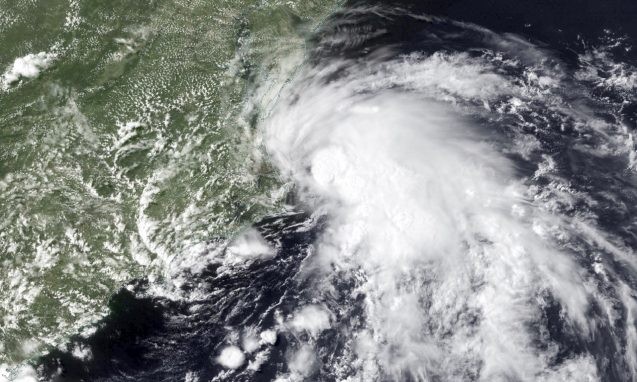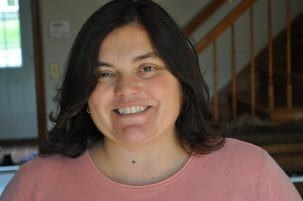Understanding and Predicting Hurricanes in a Warmer World
Scientists at Lamont-Doherty Earth Observatory use models and observations to understand tropical storms and advance the science of predicting them.

A tropical storm warning was issued for New York, New Jersey, and other mid-Atlantic states on Friday, July 10 due to Tropical Storm Fay, the earliest sixth-named storm on record. The storm made landfall near Atlantic City, N.J. on Friday evening and dumped between four and six inches of rain on some areas.
Fay follows a string of record-setting storms during the 2020 Atlantic hurricane season. It began with Tropical Storms Arthur and Bertha, who ignored the season’s official June 1 start date and formed in May. Tropical Storm Cristobal followed, setting a record for the earliest third named storm formation date. Dolly became the fourth when it developed in late June, and Edouard set a record in July for being the earliest-developing “E” storm.
This activity doesn’t mean the season will consist of a continuous string of hurricanes or storms that make landfall. But the National Oceanic and Atmospheric Administration (NOAA) Climate Prediction Center issued a forecast in May calling for a 60 percent chance of an above-normal Atlantic hurricane season. NOAA predicts between 13 and 19 named storms to occur between June 1 and November 30, and 6 to 10 of those could become hurricanes.
Scientists at Columbia University’s Lamont-Doherty Earth Observatory use computer models and observations to understand hurricanes and other tropical storms and advance the science of predicting them.
Their research will lead to a more accurate understanding of hurricanes and the risks associated with them, and how both of these may change due to global warming. As a result, communities can better prepare for storm impacts and potentially minimize losses.
Why the 2020 Hurricane Season May Be Active

Chia-Ying Lee, an atmospheric scientist and Center for Climate and Life Fellow, studies the physical processes that drive tropical cyclone formation and, in the long-term, how climate change might influence such storms.
“The two most critical environmental conditions affecting tropical cyclone seasonal activity are the sea surface temperature and vertical wind shear, that is changes in large-scale winds with height,” said Lee.
Warm ocean water helps give hurricanes their strength. Lee said the May 2020 surface temperature of the Main Development Region, the portion of the Atlantic Ocean that tends to spawn storms, was .5 degrees Celsius higher than the long-term mean—an increase large enough to indicate a more active hurricane season.
Low to moderate wind shear, coupled with warmer surface temperatures, can also encourage storm formation and intensification. And that’s another environmental condition in play this season.
“Generally speaking, El Niño enhances the large-scale vertical shear in the Atlantic and thus suppresses hurricane activity,” said Lee. “In July, the El Niño-Southern Oscillation (ENSO) state is neutral, and the NOAA Climate Prediction Center forecasts this is favored to continue through the summer, with a 50-55 percent chance of La Niña developing during Northern Hemisphere fall 2020. So the ENSO state at this hurricane season likely favors Atlantic hurricane activity.”
Advancing the Science of Prediction

Suzana Camargo, an atmospheric scientist and hurricane expert, studies the relationship between tropical cyclones and the climate. She said researchers have made significant progress in the last few years in forecasting an individual hurricane’s formation, track, and intensity, days in advance; this is the National Hurricane Center’s responsibility for the Atlantic and Eastern North Pacific.
The same is true for forecasts of the entire hurricane season, but not individual storms.
“While 30 years ago all forecasts were based on simple statistical models, currently many centers issue forecasts using climate models, which incorporate the dynamics and physics of the atmosphere,” she said.
Camargo is executive director of the Columbia Initiative on Extreme Weather and Climate, an interdisciplinary group of scientists devoted to advancing the science of predicting extreme weather events and managing associated risks.
“At Columbia, we have been working on understanding how well current models are able to predict the activity within a season, such as which weeks within the season we are expecting to be active, and which ones with very few or no storms,” she said. “That is an important issue for preparedness, and we still have a lot to understand in forecasting tropical cyclones on those time-scales.”
Understanding Climate Impacts and Risk
Hurricanes are becoming costlier and deadlier in the United States. From 2016–2018, six billion-dollar hurricanes with an inflation-adjusted loss total of $329.9 billion impacted the U.S. Three of the five most expensive hurricanes in U.S. history—Harvey, Maria, and Irma—occurred in 2017 and cost a combined $268 billion in insured losses.
The link between the growing intensity of tropical storms and human-driven climate change is less well-understood. Still, a growing body of research indicates that global warming is making hurricanes stronger.
“The upper limit of the storm intensity increases due to human-driven climate change, with the contribution of warmer sea surface temperature,” Lee said. “Thus, storm intensity increases due to human-driven climate change, too. Global climate models and the Columbia University Tropical Cyclone Hazard Model also project the growing intensity of tropical storms because of global warming.”
Camargo, Lee, and some of their colleagues have partnered with members of the insurance and reinsurance sectors on research projects that aim to reduce disaster risk and improve the resilience of communities impacted by tropical storms.
Lee says the benefit of their cross-sector collaboration is that “There is a higher layer of impact—we’re bringing the academic research to the people who practice the risk assessment.”
This post was first published by the Center for Climate and Life, a research initiative based at Columbia University’s Lamont-Doherty Earth Observatory.
